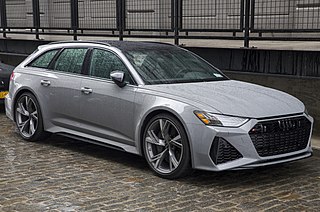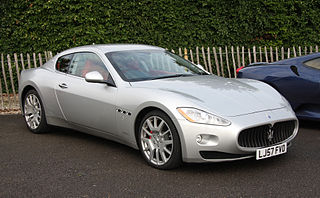
The Ferrari 575M Maranello is a two-seat, two-door, grand tourer manufactured by Italian automobile manufacturer Ferrari. Launched in 2002, it is essentially an updated 550 Maranello featuring minor styling changes from Pininfarina. The 575M was replaced by the 599 GTB in the first half of 2006.

The Lotus Exige is a British two-door, two-seat sports car made by Lotus Cars since 2000. Originally a more-hardcore coupé version of the Lotus Elise roadster, since the Series 3 the Exige has been the larger-engined model of the family - using a V6 engine in place of the Elise's straight-four with convertible versions of both available.

The Audi RS 6 is a high-performance variant of the Audi A6 range, produced by the high-performance subsidiary company Audi Sport GmbH, for its parent company Audi AG, a subsidiary of the Volkswagen Group, from 2002 onwards.

The Ferrari FXX is a high-performance track-only developmental prototype built by Italian automobile manufacturer Ferrari. The FXX is based on the street-legal flagship Enzo Ferrari. Production of the FXX began in 2005.

The Maserati GranTurismo and GranCabrio are a series of a grand tourers produced by the Italian automobile manufacturer Maserati. They succeeded the 2-door V8 grand tourers offered by the company, the Maserati Coupé, and Spyder.

The Jaguar XK is the second and final generation of the Jaguar XK 2+2 grand tourer manufactured and marketed by British automobile manufacturer Jaguar Cars under the X150 internal designation. The three-door fastback coupé debuted at the 2005 Frankfurt Motor Show with the 4.2-litre V8 engine of its predecessor, and the two-door convertible debuted in 2006 at the North American International Auto Show.

The Lamborghini Aventador is a mid-engine sportscar produced by the Italian automotive manufacturer Lamborghini. In keeping with Lamborghini tradition, the Aventador is named after a Spanish fighting bull that fought in Zaragoza, Aragón, in 1993. The Aventador is the successor for the Murciélago and was made by hand in Sant'Agata Bolognese, Italy.

The Porsche 991 is the internal designation for the seventh generation of the Porsche 911 sports car, which was unveiled at the 2011 Frankfurt Motor Show on 15 September as the replacement for the 997. The 991 was an entirely new platform, only the third since the original 911 launched in 1963. Production of the 991 generation ended on December 20, 2019, with 233,540 units produced.
The Spada Codatronca is an Italian-built supercar introduced by Spada Vetture Sport in 2008. A convertible version, the Spada Codatronca Monza, was introduced in 2012. Both cars used a modified chassis and engine from the Chevrolet Corvette C6, but featured all-new bodywork.

The McLaren 650S is a British sports car designed and manufactured by British automobile manufacturer McLaren Automotive. It was announced in February 2014 as a new model, but based on the existing MP4-12C with 25% new parts, and was formally unveiled at the 2014 Geneva Motor Show.

The Koenigsegg Regera is a limited production, plug-in hybrid grand touring sports car manufactured by Swedish automotive manufacturer Koenigsegg. It was unveiled at the March 2015 Geneva Motor Show. The name Regera is a Swedish verb, meaning "to reign" or "to rule". Koenigsegg produced only 80 units of the car, most of which were sold upon unveiling.

The Ferrari 812 Superfast is a front mid-engine, rear-wheel-drive grand tourer produced by Italian sports car manufacturer Ferrari that made its debut at the 2017 Geneva Motor Show. The 812 Superfast is the successor to the F12berlinetta.

The Techrules Ren is a single-door, high-performance sports car manufactured by Techrules, and designed by Fabrizio Giugiaro and Giorgetto Giugiaro of GFG Style. At its launch, it will become the first sports car to contain a turbine engine. This is also the first production sports car from Techrules. Expectations for the vehicle's construction are 10 (hand-built) per year.

The Polestar 1 is a 2-door plug-in hybrid sports car marketed by Polestar, a brand of Volvo Cars. It is the first car produced by the company since becoming an independent car manufacturer in June 2017. Based on Volvo's Concept Coupé from 2013, the Polestar 1 is built on the Volvo Scalable Product Architecture platform and is powered by a hybrid powertrain, using a front-mounted engine and two electric motors at the rear. A limited production run has been capped to three years with a total of 1,500 units to be produced for the left-hand drive market only. Production is to take place in Chengdu, China, where the company's first production facility was built.

The Ruf SCR is a German rear-engined sports car manufactured by German automobile manufacturer Ruf Automobile. Introduced in 2018, the styling of the SCR 2018 is inspired by the Porsche 911 (964) and its introduction pays homage to the original Ruf SCR but the new SCR uses a completely bespoke carbon-fibre monocoque chassis and body work.

The Ruf SCR is a sports car manufactured by German automobile manufacturer Ruf Automobile. The SCR was based on the Porsche 911 SC and the changes made to its engine enabled it to have similar performance to the 930 Turbo, despite having a naturally aspirated engine.

The Dallara Stradale is a sports car manufactured by Italian automotive manufacturer Dallara. The Stradale is the first road car manufactured by the company, the company's mainstream products being chassis development for other automobile manufacturers along with the development and construction of race cars. The Stradale is a barchetta in its basic form, with no doors, but is convertible to berlinetta, roadster and targa top body styles after the installation of interchangeable parts.

The Koenigsegg Jesko is a limited production mid-engine sports car produced by Swedish automobile manufacturer Koenigsegg. The car was introduced at the 2019 Geneva Motor Show and it completely sold out before the 2019 Geneva Motor Show ended. The car succeeds the Agera. The name Jesko is a tribute to the company founder's father, Jesko von Koenigsegg. There are two variations of the car – "Absolut" and "Attack" (track-focused).

The Ferrari SF90 Stradale is a mid-engine PHEV sports car produced by the Italian automobile manufacturer Ferrari. The car shares its name with the SF90 Formula One car with SF90 standing for the 90th anniversary of the Scuderia Ferrari racing team and "Stradale" meaning "made for the road".

The Koenigsegg Gemera is a limited production four-seat plug-in hybrid grand tourer to be manufactured by the Swedish automobile manufacturer Koenigsegg. It was unveiled on 3 March 2020 at an online broadcast by Koenigsegg at the cancelled Geneva Motor Show.





















